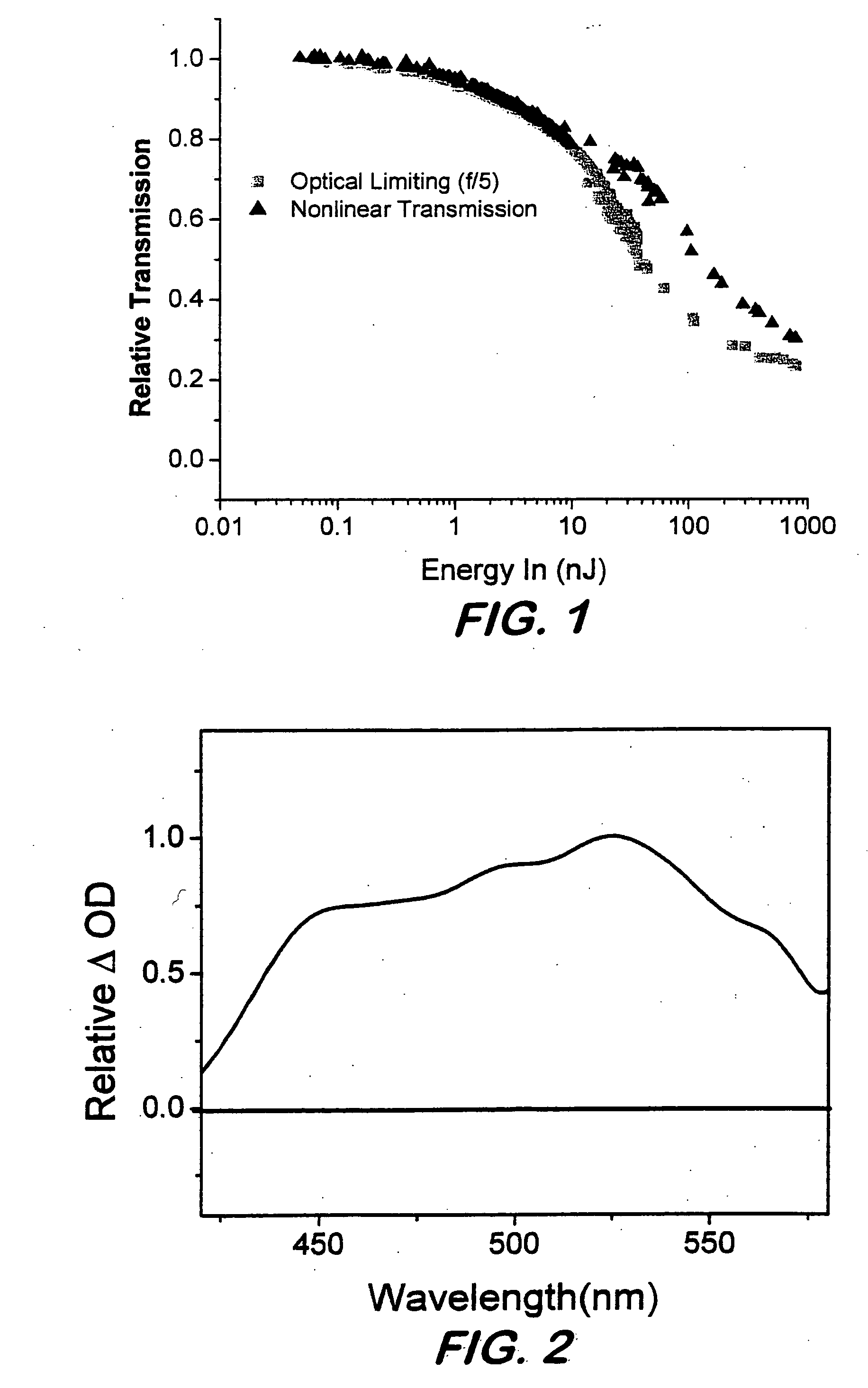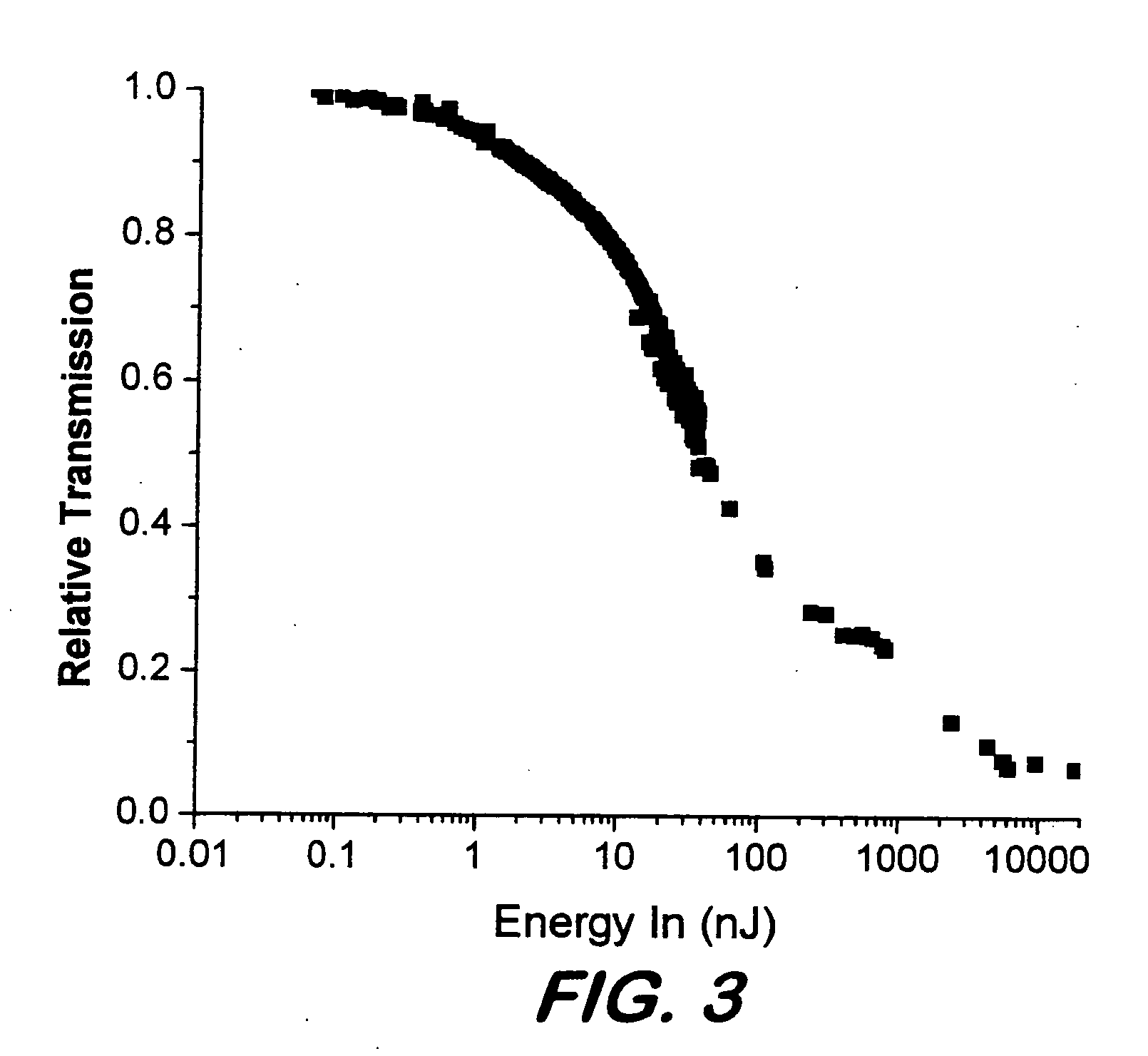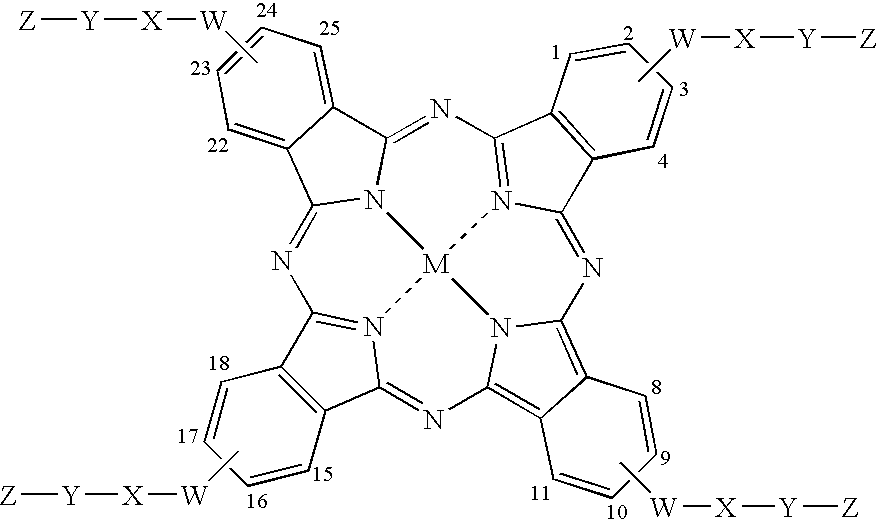Phthalocyanines with peripheral siloxane substitution
a technology of phthalocyanine and peripheral siloxane, which is applied in the field of compounding, can solve the problems of reducing the quality of the film, reducing the processing efficiency of the film, and phthalocyanine materials that do not possess the handling and processing characteristics of a single-component fluid, etc., and achieves the effect of high optical quality
- Summary
- Abstract
- Description
- Claims
- Application Information
AI Technical Summary
Benefits of technology
Problems solved by technology
Method used
Image
Examples
example 1
Synthesis and Purification of 4-(2-allylphenoxy)phthalonitrile(I)
[0051] In a nitrogen atmosphere, 6.37 g (0.046 mol) of finely grounded anhydrous K2CO3 was added to a solution of 3.89 g (0.029 mol) of 2-allylphenol (Aldrich) and 5.02 g (0.029 mol) of 4-nitrophthalonitrile (Aldrich) in 25 mL of dry Me2SO by 0.32 g additions at ½h intervals over an 6-h period. The mixture was stirred 24 hours at room temperature under nitrogen. The undissolved salt is filtered from the reaction mixture and the filtrate is dissolved in 100 mL of methylene chloride. The solution is extracted 5 times with 50 mL water. The organic phase was dried over anhydrous magnesium sulfate, filtered and evaporated to dryness. The crude product is dissolved in minimum of toluene and chromatographed on alumina with toluene elution. The toluene was evaporated and the resulting oil vacuum dried to yield 5.28 g (70%) of I. The oil turns into a solid in few days.
[0052]1H-RMN (CDCl3, 300 MHz) 3.23 (2H, d, CH2), 4.95 (2H,...
example 2
Synthesis and Purification of 4-(H9C4[Si(CH3)2O]9Si(CH3)2(CH)3C6H4O) Substituted phthalonitrile (II)
[0053] A mixture of 1 g (3.84 mmol) of 1 and 4 drops of a 0.1 N isopropanol solution of H2PtCl66H2O (Aldrich) was heated at 60° C. Then 3 g (3.84 mmol) of hydrosilyl terminated PDMS precursor (H9C4[Si(CH3)2O]9Si(CH3)2H) (A. T. Holohan et al., Macromol. Chem. Phys. 195, 2965(1994)) were added dropwise. The mixture was stirred at 60° C. for 1 h. The oil obtained was purified by silica column chromatography using toluene as eluent. The solvent was evaporated to yield 2.20 g (55%) of a colorless oil after vacuum dry.
[0054] Tg: 14° C.; nD=1.4482; 1H-RMN (CDCl3, 300 Mz) 0.012-0.064 (60H, m, SiCH3), 0.51 (4H, m, SiCH2), 0.86 (3H, t, CH3), 1.29 (4H, m, CH2), 1.58 (2H, m, CH2), 2.49 (2H, t, CH2), 6.95 (1H, d, Harom), 7.14-7.31 (5H, m, Harom), 7.68 (1H, d, Harom) ppm; IR (NaCl) 2966 (CH), 2229 (CN), 1602 and 1492 (C—C), 1254 (SiCH3), 1098 and 1033 (SiOSi), 806 (SiC) cm−1.
example 3
Synthesis and Purification of 4-(H9C4[Si(CH3)2O]18Si(CH3)2(CH2)3C6H4O) Substituted phthalonitrile (III)
[0055] The procedure is identical to that for example 2 except a longer hydrosilyl terminated PDMS precursor (H9C4[Si(CH3)2O]18Si(CH3)2H) was used, in the same stoichiometric relationship.
[0056] Tg: 10° C.; nD=1.4318; 1H-RMN (CDCl3, 300 MH) 0.015-0.144 (114H, m, SiCH3), 0.54 (4H, m, SiCH), 0.88 (3H, t, CH3), 1.32 (4H, m, CH2), 1.55 (2H, m, CH2), 2.50 (2H, t, CH2), 6.95 (1H, d, Harom), 7.15-7.32 (5H, m, Harom), 7.70 (1H, d, Harom) ppm; IR (NaCl) 2966 (CH), 2235 (CN), 1608 and 1492 (C—C), 1272 (SiCH3), 1098 and 1033 (SiOSi), 800 (SiC) cm−1.
2. Synthesis and Characterization of Lead Phtahlocyanines
[0057] The procedure for lead phthalocyanine (Pc) is very similar and analogous to those reported by Lindstead and coworkers for unsubstituted metallophthalocyanines. The general reaction and purification were as follows except where departures are specified.
[0058] To a 10×75 mm tube fi...
PUM
| Property | Measurement | Unit |
|---|---|---|
| molecular domain size | aaaaa | aaaaa |
| volume fraction | aaaaa | aaaaa |
| volume fraction | aaaaa | aaaaa |
Abstract
Description
Claims
Application Information
 Login to View More
Login to View More - R&D
- Intellectual Property
- Life Sciences
- Materials
- Tech Scout
- Unparalleled Data Quality
- Higher Quality Content
- 60% Fewer Hallucinations
Browse by: Latest US Patents, China's latest patents, Technical Efficacy Thesaurus, Application Domain, Technology Topic, Popular Technical Reports.
© 2025 PatSnap. All rights reserved.Legal|Privacy policy|Modern Slavery Act Transparency Statement|Sitemap|About US| Contact US: help@patsnap.com



